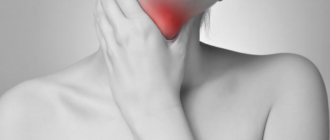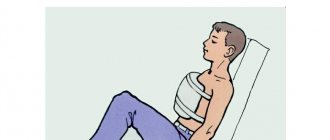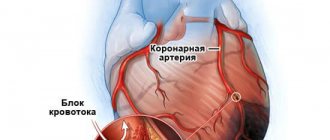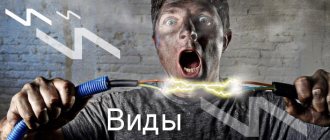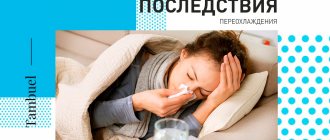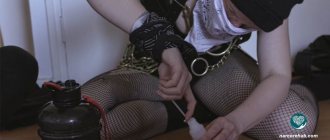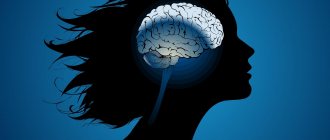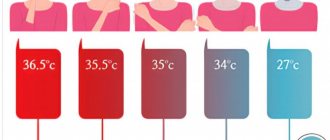The danger of atrial fibrillation attacks for the heart
The danger of attacks directly depends on the form of atrial fibrillation.
If the attacks can be stopped, that is, they can be eliminated, this must be done. Of course, it is better to choose a treatment so that paroxysms occur as rarely as possible. However, gradually, in most cases, the paroxysmal (attack-like) form of atrial fibrillation becomes permanent. In this case, another treatment is necessary - aimed at slowing down the pulse and preventing blood clots. When an attack (paroxysm) of atrial fibrillation develops, the patient has an increased likelihood of thromboembolic complications, primarily stroke, as well as myocardial infarction.
This is because the sudden onset of chaotic heartbeats disrupts the normal flow of blood into the heart and causes platelets to deposit on its inner walls. These cells form clots, which break off and travel to large arteries, such as the brain.
The faster the attack is stopped, the less the risk of complications of atrial fibrillation.
Arrhythmia in children
Arrhythmias in children can appear at any age, but are more common during the neonatal period, at 4-5, 7-8 years and in adolescents [3].
In many cases, arrhythmias are asymptomatic and are detected during routine examinations. The higher prevalence of arrhythmias in children of pubertal age is associated with hormonal age-related changes. In this case, children complain of palpitations during exercise or at rest, weakness, fatigue, headaches, insomnia, periodic chest pain and increased blood pressure. Heart failure develops quickly, especially in children of the first year of life, and can lead to sudden cardiac death syndrome. Other causes of arrhythmia in childhood:
- damage to the nervous system in the perinatal period;
- congenital dysregulation (immaturity) of autonomic regulation of cardiac activity;
- childhood infections or previous congenital infections;
- endocrinological diseases;
- dehydration with prolonged vomiting, diarrhea, sweating;
- hypo- and hyperthermia;
- congenital and acquired heart defects and conduction tract anomalies.
Complicated pregnancy and childbirth, fetal malnutrition, prematurity, intrauterine infections contribute to arrhythmias in children, and, as a rule, in children with a history of arrhythmias, various cardiac diseases are detected in close relatives.
Specifics of the work of the heart muscle
To understand what to do in case of arrhythmia, you need to understand the work of the heart muscle and the reasons why its functioning fails.
In a healthy person, the number of heartbeats varies from 60 to 90 beats per minute.
Contraction of the heart muscle occurs under the control of the sinus node, from where impulses are sent to both ventricles of the heart. This further stimulates blood pumping.
Due to many reasons, blood flow can be disrupted, that is, contractions of the heart go beyond the control of the sinus node and arrhythmia occurs.
With a low heart rate, when the readings are less than the permissible values, bradycardia is diagnosed. Over 90 heart beats per minute means the onset of tachycardia.
During an attack of arrhythmia, which appears suddenly, and the number of contractions exceeds 140 contractions per minute, paroxysmal tachycardia appears.
- Electrocardiogram for atrial fibrillation - preparation, rules of conduct, analysis of results
Doctors identify several types of manifestations of cardiac arrhythmia:
- Flickering. The most dangerous manifestation of tachycardia, which is characterized by chaotic contraction of the heart muscle, reaching up to 600 beats per minute. Help for atrial fibrillation should be provided immediately, as otherwise a heart attack may develop.
- Sinus. It occurs against the background of neuroses and chronic diseases of the cardiovascular system. Characterized by different intervals between muscle contractions.
- Extrasystolic. It manifests itself as an irregular alternation of stopping contractions followed by sharp jerks.
If the patient first encounters manifestations of arrhythmia, he needs to undergo diagnostics at a medical institution, since the type of heart contraction disorders is determined by the doctor after a detailed examination using an ECG.
It is important!
In the case of low blood pressure, it is prohibited to self-prescribe medications to eliminate arrhythmia, since they have the property of reducing it even further.
Diagnostics
Of course, the central role in the diagnosis of arrhythmias is played by electrocardiogram analysis, single ECG recording or 24-hour (Holter) monitoring.
An ECG with stress and functional studies are performed. Sometimes a revil-implantable device is installed that continuously records the ECG for several months. Additionally, an electroencephalogram, genetic testing, MRI or CT scan of the heart, and echocardiography are performed. Laboratory methods for diagnosing arrhythmias in order to identify electrolyte disturbances and signs of inflammation deserve special attention. Blood, urine, nail or hair tests are taken to determine the levels of magnesium, potassium, sodium, and chlorine. Blood tests are more revealing.
You can perform a complex laboratory test "Cardiorisk", including determination of troponin levels, NT-pro BNP; C-reactive protein, homocysteine, triglycerides, lipoprotein, creatine kinase, LDH, cholesterol, low and high density lipoproteins, D-dimer.
To monitor the effectiveness of treatment, a study of the level of drugs amiodarone, lidocaine, procainamide in the blood is prescribed using high-performance liquid chromatography.
First aid for arrhythmia at home: what to do?
If an attack occurs for the first time, you need to call an ambulance as quickly as possible for the reason that identifying the type of arrhythmia on your own is very problematic. Help at home while waiting for a paramedic involves the following actions:
- Pre-medical support begins with ventilation of the room. In case of shortness of breath, it is better to place the patient in a semi-sitting position, unbutton his shirt buttons or remove items of clothing that interfere with normal breathing.
- It is worth measuring your pulse and blood pressure.
- In some cases, changing positions (from lying to sitting, and vice versa) can prevent an impending attack.
- While waiting for a team of emergency doctors, you can use manual therapy methods as the safest ones. Every few seconds it is necessary to apply gentle pressure on the eyelids. Also, emotional support and the creation of a comfortable, relaxing atmosphere are extremely important for the patient.
What to do if you have cardiac arrhythmia? It is not recommended to take drugs with antiarrhythmic effects without a doctor's permission. As a last resort, it is permissible to take a Valocordin (Corvalol) tablet or another sedative prescribed by a cardiologist. Emergency care for atrial fibrillation will be much more effective if you provide the doctor with the following information:
- Data on heart rate measurements and blood pressure levels (recorded in mm Hg), which should be recorded daily in a separate notebook or notepad.
- Factors preceding the onset of an attack (stressful situations, alcohol consumption, withdrawal of a particular drug).
- The patient’s complaints before and during the attack, features of well-being after the heart rhythm was restored.
In case of a very low pulse, the patient's head is thrown back to facilitate the flow of oxygen. Fainting requires artificial respiration or chest massage, which must be performed by a person with certain training. This technique often helps: the patient’s face is placed under a stream of cold water or lowered into a reservoir. In this way, it is possible to achieve a reflex reduction in the frequency of contractions of the heart muscle, which makes it possible to stop the attack. In case of bradycardia, the patient is recommended to take a supine position so that the legs are higher than the level of the head.
If the first prehospital care for arrhythmia does not bring positive results, the gag reflex should be provoked by irritating the larynx area with the fingers. Thanks to such stimulation, it is possible to stabilize the heart rate even in the absence of vomit. If there is shortness of breath or swelling, which often accompanies atrial fibrillation, it is worth helping the patient sit up. In critical situations, when breathing or heartbeat stops, emergency pulmonary-cardiac resuscitation is performed. For certain types of arrhythmias, the following treatment is suggested:
- For extrasystole, potassium preparations, sedatives and medications containing toxic atropine are used mainly. If attacks become more frequent, the patient requires hospitalization with a course of intravenous administration of Lidocaine and intensive therapy for the disease that provoked the occurrence of arrhythmia.
- In the case of sinus bradycardia, they usually resort to vasodilator drugs, such as Actovegin and Zufillin. If complications occur, the patient may need a pacemaker.
- An attack of paroxysmal tachycardia requires massage of the eyeballs, artificial induction of vomiting and pressure on the abdominal area. If the above methods do not have the desired effect, the patient may need urgent hospitalization.
When atrial fibrillation worsens, it is worth lowering the ventricular rate, for which they resort to electrical pulse therapy, Quinidine, Digoxin, as well as medications from the group of anticoagulants (one of the most effective representatives is Coumadin).
In the case of asystole, atrial and ventricular flutter, they often resort to urgent cardiac massage, the use of calcium chloride, lidocaine injections, temporary cardiac stimulation or surgery.
Certain medications for arrhythmia, which include coagulants and other potent drugs, have a number of serious side effects, including internal bleeding. Therefore, they should be prescribed exclusively by the attending physician, based on the results of biochemical tests, ultrasound examinations and the individual characteristics of the patient.
- How to provide first emergency aid for atrial fibrillation?
How to take medications and control your condition?
Each patient taking tablets for arrhythmia should be regularly monitored by a doctor. Timely examination allows you to assess the effectiveness of therapy, identify side effects in the early stages and take measures to eliminate them. During the examination, the doctor evaluates the following indicators:
- General condition and complaints of the patient.
- Blood pressure numbers.
- Pulse.
- Heart rate.
- Heart rhythm according to electrocardiogram or Holter monitoring results.
- State of the cardiovascular system according to ultrasound and echocardiography.
- General blood test, coagulogram, biochemical parameters, lipid profile.
- Electrolytes in the blood.
- Kidney and liver tests.
- Hormones.
Forms of atrial fibrillation
Atrial fibrillation (atrial fibrillation) can occur in several variants (forms):
- paroxysmal form: usually the patient has a normal sinus rhythm, but periodically it “breaks down” and an attack of irregular heartbeat develops, usually rapid;
- persistent form: the patient’s usual rhythm is atrial fibrillation, but sometimes due to unknown reasons, his normal heartbeat is restored for some time;
- permanent form: only an irregular heartbeat is recorded, sinus rhythm is not restored.
And also, depending on the average pulse frequency, tachysystolic, normo- and bradysystolic forms of atrial fibrillation are distinguished.
Tachysystolic form - an increase in the average heart rate of more than 100 per minute.
Normosystolic form with heart rate from 60 to 100 beats,
Bradysystolic form is a decrease in heart rate of less than 50 - 60 per minute.
In the paroxysmal course of MA, attacks usually have a high heart rate.
Medicines that reduce the flow of sodium ions into heart cells.
As is known, the occurrence and propagation of an electrical impulse in cells in general and in heart cells in particular is associated with the activity of ion channels, among which a special role belongs to the sodium channel. Substances that block these channels stabilize cell membranes (they are also called membrane-stabilizing) and prevent the abnormal occurrence and propagation of electrical impulses. A malfunctioning cell becomes electrically “silent”, while the activity of normal cells does not change. However, with increasing doses, these substances suppress impulse conduction in normal tissues, provoking arrhythmia. Moreover, even a therapeutic concentration of the drug can become “arrhythmogenic” with rapid heartbeat, acidosis or hyperkalemia.
The ancestor of drugs in this group is quinidine, which is a derivative of quinine, an alkaloid from the bark of the cinchona tree. It also includes procainamide, disopyramide, lidocaine, mexiletine, moricizine, propafenone and others. They all have the same mechanism of action, similar to the action of local anesthetics that block sodium channels inside the cell.
General rules for first aid
The rules for providing first aid for the treatment of paroxysm of atrial fibrillation are carried out differently depending on several characteristics of the attack:
- blood pressure level;
- shortness of breath at rest;
- duration of the attack;
- heart rate;
- primary or repeated paroxysm.
Depending on this, emergency doctors either try to restore sinus rhythm or reduce the heart rate, while simultaneously preventing the formation of blood clots. For this purpose, medications are used, and, if necessary and conditions exist, electropulse therapy is used.
What you can and cannot do at home during an attack
If an attack of irregular heartbeat develops, you must immediately call an ambulance.
Before the medical team arrives, you can:
- give the patient a semi-sitting position;
- unbutton tight clothes;
- provide fresh air access to the room;
- invite the patient to breathe with his stomach, wipe his face with a handkerchief dipped in cold water;
- give 20 - 30 drops of Corvalol in half a glass of water;
- prepare for the arrival of the team: organize its meeting, prepare medical documents, previous ECGs, think about transporting the patient to the ambulance (such a need may arise, but the duties of the ambulance personnel do not include carrying the patient);
- reassure the patient, tell him to call the doctors.
When detecting an attack of MA before the arrival of the ambulance, you cannot:
- Diet for atrial fibrillation: permitted and prohibited foods, sample menu
- give the patient medications before the ambulance arrives, including nitroglycerin;
- massage the eyeballs or the area of the carotid arteries;
- waste time measuring blood pressure without preparing for the arrival of medical personnel;
- collect things for hospitalization (this will be the time while the doctor examines the patient, relieves the attack, etc.; hospitalization is not always required);
- worry and panic.
How to stop an attack of MA on your own (a pill in your pocket)
Some patients whose diagnosis of “paroxysmal atrial fibrillation” has been established for a long time, and attacks occur less than once a month, can learn to independently stop such paroxysms. This tactic is called “pill in the pocket.”
It is used in intellectually intact patients who can adequately assess their condition. The “pill in your pocket” strategy should not be used if the next attack of arrhythmia caused any new symptoms:
- chest pain;
- dizziness;
- weakness in the limbs;
- facial asymmetry and so on.
In such cases, you should not stop the paroxysm on your own, since these symptoms may be a sign of the development of a heart attack or stroke.
If paroxysmal fibrillation proceeds as usual, the patient can take the drug propanorm at a dosage of 450–600 mg.
The patient should consult his cardiologist in advance about in what cases and in what dose to take this medicine. It is better if the first dose of propanorm is taken in a hospital, under the supervision of medical professionals.
What is the drug treatment?
In the practice of cardiologists and therapists, the international classification of antiarrhythmic drugs by class and generation is often used. Thus, there are four types, which are presented in the list of drugs for cardiac arrhythmia by name. Membrane stabilizing agents of the first class are divided into groups I a, I b and I c, depending on their type of exposure. Drugs of group I a and I c affect sodium ion channels, I b - potassium ion channels. The second class consists of beta-adrenergic blockers. The third is prolonging and slowing down the passage of the potential, blocking the flow of potassium ions through the membranes. The fourth is antiarrhythmics, affecting the flow of calcium in the heart muscles. Fifth - combines other medications with similar effects. According to the division, the following is used in treatment:
- I class:
- I a – “Quinidine”, “Procainamide”, “Disopyramide”, “Ajmalin”;
- I b – “Lidocaine”, “Mexilitine”, “Trimecaine”, “Difenin”;
- I c – “Flecainide”, “Propafenone”, “Etatsizin”, “Allapinin”.
- Class II: “Propranolol”, “Metoprolol”, “Bisoprolol”, “Esmolol”, “Atenolol”, “Anaprilin”.
- Class III: Amiodarone, Sotanolol, Dofetilide, Azimilide, Bretilium.
- IV class. "Verapamil", "Diltiazem".
- Class V: “Digoxin”, “Magnesium sulfate”, “Potassium chloride”, “Adenosine triphosphate”.
Mechanism of action and pharmacodynamics of drugs
The normal sinus rhythm of the heart is disrupted by changes in excitability, automaticity, conduction or formation of impulses in the myocardium. The principle of action of drugs for arrhythmia is a pronounced effect on the transmission of ions and electrical potentials of cardiomyocytes (muscle cells of the heart). This allows you to normalize the frequency and strength of contractions using medications without surgery or installing a pacemaker. Depending on the class and group, the drugs have the following effects:
- stabilize cardiomyocyte membranes and act on sodium and potassium channels;
- influence adrenergic receptors and the sympathetic nervous system;
- block current in the membranes of heart cells.
In the wall of each muscle cell of the heart there are many channels through which potassium, sodium, calcium and chlorine ions enter. As particles move, an action potential is formed and impulses propagate through the conduction system. This process ensures contractility in the correct rhythm. With arrhythmia, nerve impulses travel abnormally. This occurs as a result of new foci of activity, or when the current wanders in the wrong direction. Arrhythmia medications prevent this. Let us consider in more detail each of the classes and the characteristics of its representatives.
Sodium channel blockers
These medications can block sodium from entering the cell. They slow down the passage of the excitation wave through the myocardium, which can lead to the cessation of arrhythmia.
Effects:
- inhibition of the sinus node and other pacemakers;
- decreased myocardial excitability;
- decrease in the speed of excitation;
- decreased blood pressure;
- decrease in minute blood volume.
Within the class, subclasses are distinguished based on the properties of drugs to affect different types of arrhythmias. For example, some medications cope better with supraventricular arrhythmias, others with ventricular arrhythmias.
I A class
This group includes drugs that have a membrane-stabilizing effect: “Novocainamide”, “Quinidine”, “Ajmalin”.
"Quinidine" is an alkaloid. It is obtained from the bark of the cinchona tree.
Indications:
- ventricular and supraventricular tachycardia;
- atrial fibrillation;
- extrasystole;
- prevention of attacks of paroxysmal tachycardia.
Contraindications:
- heart failure;
- active inflammatory process in the myocardium;
- complete atrioventricular block;
- thrombus in the atria;
- pregnancy;
- atrial fibrillation due to thyrotoxicosis.
Side effects:
- dyspepsia;
- dizziness;
- hearing and vision impairment;
- arterial hypotension;
- heart failure;
- atrioventricular block;
- thrombocytopenic purpura.
“Novocainamide” is a synthetic derivative of novocaine.
Indications:
- paroxysmal ventricular and supraventricular tachycardia;
- atrial fibrillation;
- atrial flutter;
- ventricular extrasystole.
Contraindications:
- heart failure;
- arterial hypotension;
- atrioventricular block;
- impaired liver and kidney function;
- parkinsonism.
Side effects:
- allergic reactions;
- nausea;
- vomit;
- insomnia;
- excitation;
- headache;
- convulsions;
- arterial hypotension;
- disruption of cardiac muscle conduction;
- ventricular flutter.
"Ajmaline" is a rauwolfia alkaloid.
Indications:
- ventricular arrhythmia in patients with myocardial infarction;
- Wolff-Parkinson-White syndrome.
Contraindications:
- severe conduction disturbances;
- myocarditis;
- circulatory failure stage III;
- arterial hypotension.
Side effect:
- general weakness;
- nausea;
- vomit;
- arterial hypotension;
- feeling of heat.
I B class
This class includes: “Lidocaine”, “Trimecaine”, “Mexiletine”.
Their difference is that they have little effect on the sinus node, atria and atrioventricular connection, therefore they do not give the desired effect for supraventricular arrhythmias, but they relieve ventricular tachycardia and extrasystoles excellently. Also, these tablets for arrhythmia cope perfectly with disorders that arise as a result of an overdose of cardiac glycosides.
The most prominent representative of the group is Lidocaine .
Indications:
- ventricular extrasystole;
- ventricular tachycardia;
- prevention of ventricular fibrillation, especially in the acute period of myocardial infarction;
- glycoside intoxication;
- anesthesia
Contraindications:
- epilepsy;
- allergy to lidocaine;
- sick sinus syndrome;
- bradycardia;
- cardiogenic shock;
- atrioventricular blockades of the 1st-3rd degree;
- glaucoma.
Side effects:
- psychomotor agitation;
- dizziness;
- convulsions;
- visual and speech impairment;
- collapse;
- allergy.
I C class
Includes “Etatsizin”, “Flecainide”, “Propafenone” (trade name “Ritmonorm”).
Representatives of this subclass have a strong antiarrhythmic effect. They can also provoke arrhythmia themselves (proarrhythmic effect) in some patients with myocardial infarction or heart failure.
"Propaphenone"
Indications:
- prevention and treatment of ventricular extrasystole;
- atrial fibrillation;
- supraventricular tachycardia;
- Wolff-Parkinson-White syndrome;
- Clerk-Levy-Christesco syndrome.
Contraindications:
- heart failure;
- cardiogenic shock;
- sinus bradycardia;
- weakness of the sinus node;
- arterial hypotension;
- cardiac conduction disturbance;
- myasthenia gravis;
- bronchospasm;
- obstructive pulmonary diseases.
Side effects:
- nausea;
- vomit;
- gastroenteritis;
- constipation;
- dizziness;
- insomnia;
- bronchospasm;
- anemia;
- leukopenia.
Beta blockers
Many diseases are accompanied by increased tone of the sympathetic nervous system (arterial hypertension, coronary artery disease, vegetative-vascular dystonia). This leads to the release of a large amount of adrenaline into the blood, which increases the frequency of generated impulses. Beta blockers can reduce this effect and normalize the pulse, while providing a pronounced hypotensive effect.
Representatives of the class are divided into:
- non-selective beta-blockers: Anaprilin (Propranolol), Sotalol;
- selective beta blockers: Bisoprolol (Concor), Nebivalol, Metoprolol, Atenolol;
- alpha-beta adrenergic blockers: Carvedilol, Labetalol.
"Anaprilin"
Indications:
- arterial hypertension;
- angina pectoris;
- sinus tachycardia;
- myocardial infarction;
- hypertrophic cardiomyopathy;
- mitral valve prolapse;
- vegetative-vascular dystonia;
- combination therapy for pheochromocytoma;
- essential tremor.
Contraindications:
- cardiogenic shock;
- atrioventricular block of the 2nd-3rd degree;
- sinoatrial block;
- sick sinus syndrome;
- sinus bradycardia;
- Prinzmetal's angina;
- arterial hypotension;
- acute and chronic heart failure;
- severe bronchial asthma;
- Raynaud's syndrome.
"Metoprolol"
Indications:
- hypertension;
- cardiac ischemia;
- myocardial infarction;
- tachyarrhythmias;
- migraine.
Contraindications are the same as for Anaprilin.
"Carvedilol" is more effective in cases where rhythm disturbances are combined with chronic heart failure.
Potassium channel blockers
These medications primarily block potassium channels, but also have an effect on beta-adrenergic receptors.
They are capable of:
- slow down the conduction of impulses through the myocardium;
- reduce the automaticity of the sinus node;
- dilate the vessels of the heart and fill them with blood;
- reduce pressure.
The most commonly used drug for arrhythmia from this group is Amiodarone (Cordarone) .
Indications:
- ventricular tachycardia;
- ventricular fibrillation;
- atrial fibrillation and flutter;
- paroxysmal supraventricular tachycardia;
- Wolff-Parkinson-White syndrome;
- nodal tachycardia.
Contraindications:
- bradycardia;
- thyroid diseases;
- sensitivity to iodine;
- pulmonary fibrosis;
- liver failure;
- pregnancy;
- lactation.
Slow calcium channel blockers
These drugs block the flow of calcium through slow channels into cardiomyocytes. In practice, they are divided into dihydropyridine derivatives (Nifedipine, Amlodipine) and non-hydropyridine derivatives (Verapamil).
The difference between the groups is that the first is capable of reflexively increasing the heart rate, so they are not used to treat arrhythmias!
"Verapamil"
Indications for use:
- paroxysmal supraventricular tachycardia;
- atrial flutter and fibrillation;
- high blood pressure;
- extrasystole;
- vasospastic angina;
- cardiac ischemia.
Contraindications:
- bradycardia;
- sick sinus syndrome;
- ventricular tachycardia;
- tachycardia with a wide QRS complex;
- cardiogenic shock;
- atrioventricular block of ІІ-ІІІ degrees;
- Wolff-Parkinson-White syndrome;
- arterial hypotension;
- acute myocardial infarction;
- heart failure;
- sinoatrial block;
- liver failure.
Other antiarrhythmic drugs
These include:
- cardiac glycosides: Digoxin;
- potassium preparations: “Panangin”, “Asparkam”;
- metabolic drugs: Adenosine, ATP-long, Riboxin.
Cardiac glycosides are used in cases where it is necessary to stop supraventricular tachycardia and restore sinus rhythm during atrial fibrillation. But they are contraindicated in bradycardia, intracardiac block and Wolff-Parkinson-White syndrome. In case of an overdose, nausea, vomiting, abdominal pain, headache, nosebleeds, blurred vision, and insomnia may occur as a consequence of glycoside intoxication.
Potassium preparations help reduce the activity of electrical processes in the myocardium. They are used for the treatment (albeit mostly for prevention) of supraventricular and ventricular arrhythmias. Side effects: malignant slowing of heart rate, nausea, vomiting, deterioration of atrioventricular conduction.
How to stop arrhythmia
Some types of arrhythmias (ventricular and atrial extrasystole) may not be treated at all if the number of extrasystoles per day is small. But in most cases, arrhythmia still needs to be treated. For this purpose, there are special antiarrhythmic drugs that a cardiologist can select for you. In case of severe cases of some types of arrhythmias, it will be necessary to prescribe droppers or treatment with electric current - electric pulse therapy. In the most difficult cases, surgical intervention is performed. Folk remedies for arrhythmia should not be used; treatment should be trusted exclusively to a cardiologist. It is very important to monitor the dynamics of the disease and adjust therapy in a timely manner.

